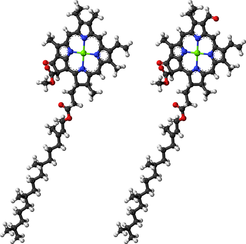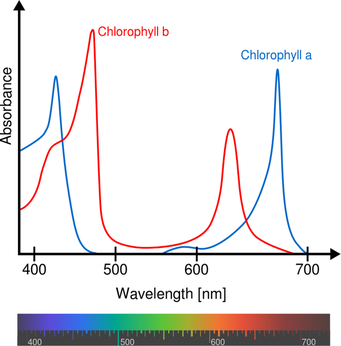The true color of chlorophyll
The light harvesters in plant photosynthesis are bluer than we think

Most leaves come in various shades of green. This is due to pigments called chlorophyll. The name comes from the Greek words chloros (green) and phyllon (leaf). There are six types of chlorophyll in nature. The two main types in plants are chlorophyll a and chlorophyll b.

Chlorophyll a absorbs violet and orange light the most. Chlorophyll b absorbs mostly blue and yellow light. They both also absorb light of other wavelengths with less intensity. However, none of them absorbs green, so the leaf looks green because that light is reflected to our eyes instead of being absorbed by the leaf. Since there are no other strong pigments present in leaves, that is the whole story.
Chlorophyll molecules have a ring shape at one end – called a porphyrin – with a magnesium ion in the center. If you boil a leaf in water, this magnesium ion gets replaced by a hydrogen ion – i.e. a proton – and the color changes from bright green to the dull color of overcooked broccoli. A slight change of the molecular structure leads to a change of the optical behavior. Furthermore, chlorophyll a and b only differ in a substituent of the porphyrin, for chlorophyll a it is a methyl group (-CH3) and for chlorophyll b it is an aldehyde group (-CHO) in the C7 position, but it is sufficient to significantly alter the absorption spectrum of the molecule.

Photosynthetic chlorophyll pigments are not alone in the leaf cells; they are usually in a protein pocket. It is this interaction with the surrounding microenvironment what fine-tunes chlorophylls to cover as much of the visible spectrum as possible. To know how much this microenvironment affects the visible color, we first need to know what the true color of chlorophyll is. This is very important if we are ever going to understand how photosynthesis works and if we want to use this knowledge to build truly efficient photovoltaic devices.
This is not an easy question to answer, though. You might think that it is as simple as preparing a solution of chlorophyll and use a spectrometer to get the answer. This has already been done with different solvents. The problem with this method is that these solvents have an effect on the electronic structure of the chlorophyll molecule, namely on the electron cloud at the porphyrin, thus modifying its optical behavior. Now, Angel Rubio and his colleagues have developed a method to measure the true color of chlorophyll in the absence of perturbations from its environment.
The method consists in tagging the chlorophyll a and b molecules with three different ammonium cations – i.e. positively charged ions – with no mobile protons, so that in each case the distance between the chlorophyll and the electric charge is known. Then, dissolved mixtures of chlorophyll and tags are electrosprayed into a vacuum within a spectrometer. Excitation of the molecules by laser light leads to the dissociation of chlorophylls and tags, thus allowing the measurement of the chlorophyll spectra for different cations.
The spectra obtained by the researchers using this method show negligible dependence on the nature of the tag cation. This would mean that the cations are far enough from the porphyrin that confers its optical properties to chlorophylls. This possibility was confirmed using ab initio calculations: the results showed that the tag has minimal influence on the excitation energy and therefore on the wavelengths the chlorophyll molecules absorb; the shift in the absorption wavelengths is actually less than 10 nanometers (nm).
So, what is the true color of chlorophylls? In the case of chlorophyll a the maximal absorption in the red region is at 642 nm and in the blue region at 372 nm; for chlorophyll b the values are 626 nm and 392 nm, respectively. This means that the environment red-shifts the absorption spectra of chlorophyll in plant cells or, in other words, chlorophyll pigments are bluer than we think.














